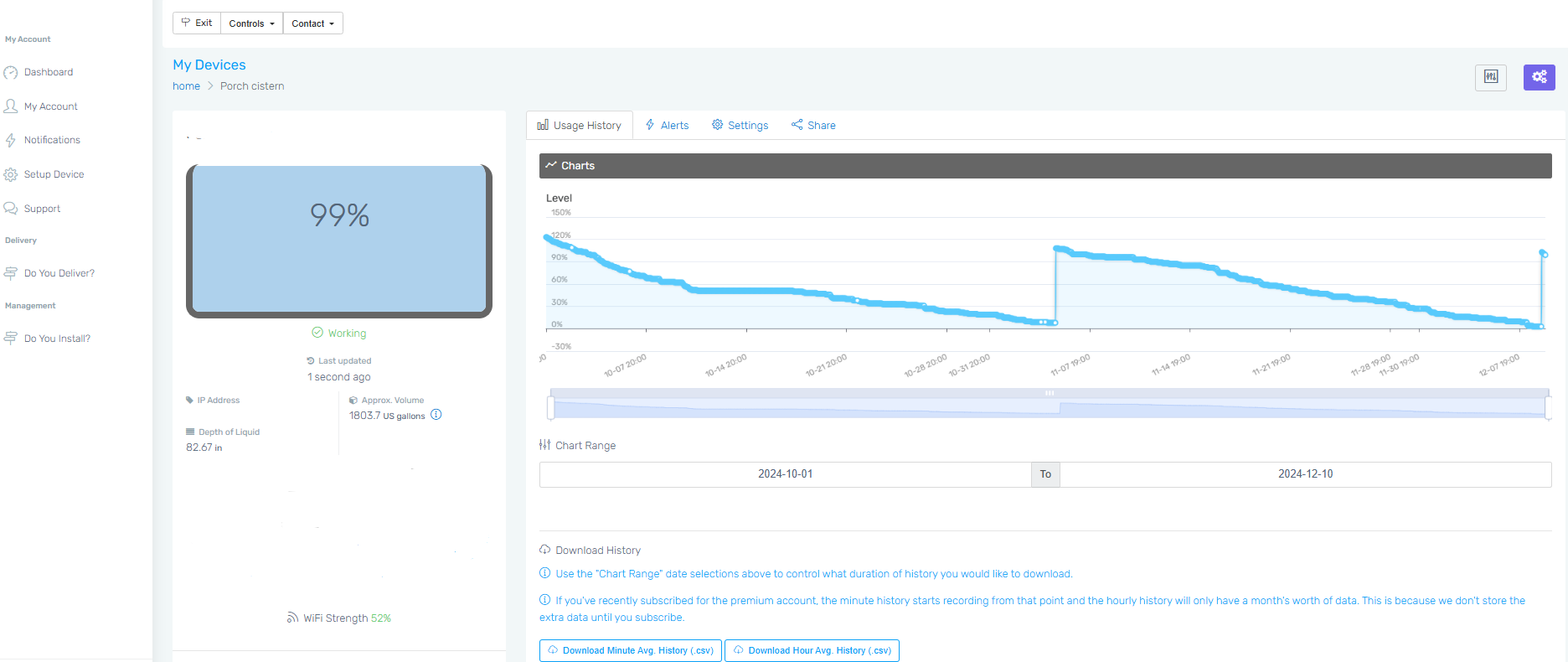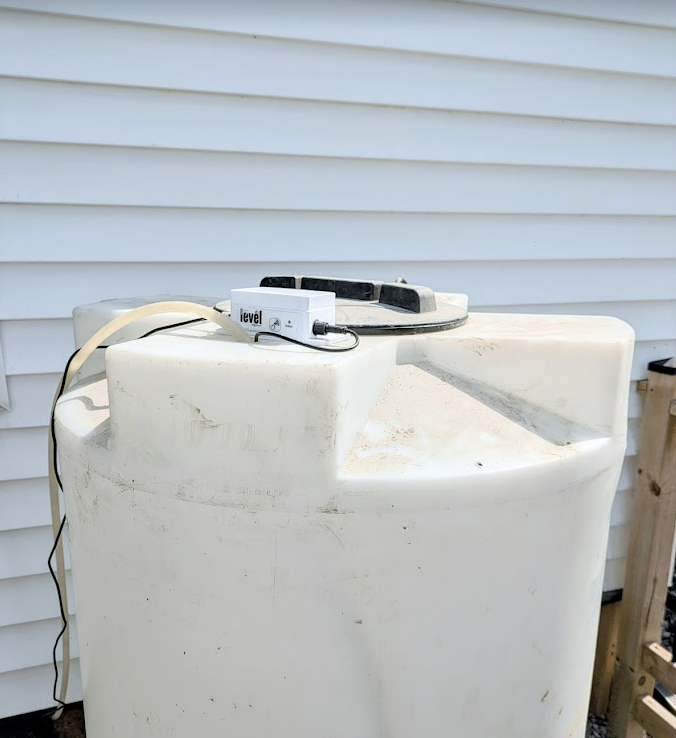How to save money on your cistern water bill
Managing water levels in your cistern or tank isn’t just about convenience—it’s also about saving money. The PTLevel, with its accurate monitoring, alert system, and data-sharing capabilities, can help you avoid unnecessary water deliveries and optimize your water usage.
Scroll to the bottom of this article to use our free water savings calculator.
Here’s how you can save money on your cistern water bill with the PTLevel:
The Cost of Guessing
For many, ordering water is a guessing game. You might call for a refill when you think your cistern is low, only to find out it wasn’t as empty as you thought. This can really affect how to save money on your cistern water bill. Or worse, you forget to check, and the tank runs dry, leading to emergency deliveries with added fees.
Other people opt for routine monthly deliveries to avoid running out of water. While this may seem convenient, it often leads to over-delivery, where your tank is filled more often than necessary. Paying for water you don’t need is money wasted.
Both scenarios cost you money—and peace of mind. That’s where the PTLevel comes in to help save money on your cistern water bill.
Smarter Water Management
The PTLevel provides real-time data on your water levels, accessible right from your smartphone or computer. With this innovative device, you can:
Eliminate Routine Overordering: Stop wasting money on unnecessary monthly cistern water deliveries and bills.
Order When Needed: Schedule water deliveries only when your tank is nearing empty.
Avoid Emergency Fees: Set low-water alerts to ensure you never run out unexpectedly.
Share Levels with Your Water Delivery Company: Grant access to your PTLevel data so they can monitor your levels and deliver water exactly when you need it, helping you on how to save your cistern water bill money effectively.
Monitor Water Usage Remotely: Property managers can keep an eye on water levels, even when others are in the home, like Airbnb tenants. This ensures proper water usage and helps you stay on top of any unexpected spikes in consumption.
By relying on precise data, you avoid the cost of guesswork and bring efficiency to your water delivery process.
Why Does a Water Delivery Cost So Much?
Water delivery costs can seem high because the true expense lies not in the water itself but in getting it to your location. Delivery services must account for a range of operational costs, including driver wages, vehicle fuel, and commercial insurance. Maintaining large delivery trucks is particularly expensive, as these vehicles undergo significant wear and tear. Additionally, emergency or after-hours deliveries come with added costs due to overtime pay and the logistical challenges of adjusting schedules to meet urgent requests.
These factors contribute to the overall cost of the service, ensuring reliable and timely delivery regardless of circumstances. While the water might be inexpensive, the infrastructure, labor, and resources required to bring it to your door drive up the price. This is why effective water management and tools like the PTLevel can help minimize the need for unexpected or frequent deliveries, saving you money over time and showing you how to save money on your cistern water bill.
Are you a water hauling business? Find out how the free PTDevice portal for Water Delivery Businesses can save you money and help customers find you!

How PTLevel Saves You Money
Running out of water can lead to emergency delivery charges or temporary fixes like purchasing bottled water for household needs. These costs add up quickly. Knowing how to save money on your cistern water bill can help manage these scenarios.
Sharing your PTLevel data with your water delivery company allows them to deliver precisely when your tank requires it—no sooner, no later. This prevents premature deliveries and ensures you always have enough water without overstocking.
Many water delivery companies charge per trip or have a minimum fill requirement. With routine deliveries, you might be paying for water you don’t yet need. The PTLevel ensures your tank is only filled when necessary.
If you’re managing an Airbnb or other rental property, the PTLevel lets you keep tabs on water usage while guests are in the home. This ensures responsible usage and alerts you to potential overuse or leaks that might require attention, ultimately leading to how to save money on your cistern water bill in such properties.
The PTLevel helps you track patterns in your water usage, allowing you to optimize consumption and spot issues like leaks or overuse. Addressing these problems saves you money in the long run.
Take Control of Your Water Budget
The PTLevel isn’t just a monitoring device—it’s a money-saving tool that helps you and your water delivery company work smarter, not harder. Whether you’re managing a household cisternhttps://paremtech.com/outdoor-cistern-level-monitoring/, a commercial tank, or a property with rotating tenants, the PTLevel puts you in control by:
Cutting out unnecessary expenses from routine or emergency deliveries.
Giving property managers oversight of water usage when others are in the home.
Ensuring peace of mind that your water supply is sufficient.
Let’s do a money-saving case study!
Scenario:
Tank starts full (100%) and is refilled when it reaches either 30% or 10%.
Waiting to refill at 10% extends the refill cycle by 1.5 weeks.
Assumptions:
30% Refill Cycle: Takes 4 weeks to go from 100% to 30%.
10% Refill Cycle: Takes 5.5 weeks to go from 100% to 10%.
Each delivery costs $300.
Calculation:
Deliveries per year = 52 weeks ÷ refill cycle duration (weeks).
Total cost = deliveries per year × $300.
Annual savings = cost difference between the two scenarios.

Explanation
If you refill at 30%, you’ll need 13 deliveries per year, costing $3,900.
If you wait to refill at 10%, you’ll only need 9 deliveries per year, costing $2,836.
This results in $1,064 in annual savings.
Use the calculator below to calculate your savings!
Water Delivery Savings Calculator
Results:
Deliveries per Year (Without PTLevel): 0
Deliveries per Year (With PTLevel): 0
Total Cost (Without PTLevel): $0
Total Cost (With PTLevel): $0
Annual Savings: $0



